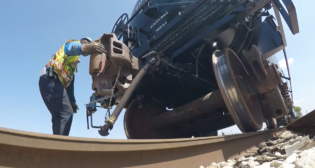
Impact Control With Limited Slack Action: Measuring Long-Travel Draft System Performance
Written by Adam Klopp, Principal Investigator, Transportation Technology Center, Inc.RAILWAY AGE, JULY 2020 ISSUE, TTCI R&D: Draft systems are important contributors to train performance because, among effects, these systems limit the relative motion between coupled vehicles in a train and absorb energy during impact events. An end-of-car cushioning (EOCC) unit is a type of long-travel draft system that uses hydraulic cylinders in place of standard friction draft gears to absorb energy and improve yard impact performance. EOCC units absorb energy when coupler forces are applied by forcing oil from a high-pressure inner cylinder to a low-pressure outer casing through various preloaded orifices over a long displacement stroke, which is typically 10 or 15 inches.
Transportation Technology Center, Inc. (TTCI) is conducting research under the Association of American Railroads (AAR) Strategic Research Initiatives (SRI) program to characterize, evaluate and improve performance of long travel draft systems. Initial efforts in this research focused on the development and validation of models to simulate impacts of cars equipped with 10-inch and 15-inch EOCC units using NUCARS®, (a TTCI registered trademark), TTCI’s multibody vehicle-track interaction software.
Results from the 10-inch and 15-inch EOCC impact simulations correlated well with measured data for buff and draft impacts. Characteristics from the impact models were then used to simulate and analyze the coupler forces in trains with cars containing EOCC units. Train dynamics simulations were conducted using TTCI’s Train Operation and Energy Simulator (TOES) program to evaluate the in-train performance and slack control of 10-inch and 15-inch EOCC units in OTR (over-the-road) type environments. The NUCARS® impact simulations were used to establish the baseline performance of EOCC units during impacts in a yard-type environment, and the TOES simulations were used to establish the baseline coupler forces of trains containing EOCC as they negotiated different challenging revenue service routes. The baseline results from these simulations were then used for comparisons to evaluate different draft systems and EOCC unit variations.
Approximately 15% of railcars in the North American fleet are equipped with EOCC units, including autoracks, flat cars and boxcars. EOCC units provide necessary impact protection for cars and lading in high-force, high-acceleration yard environments, but they can cause slack action issues during normal train operations due to their long travel. Standard friction draft gears do not provide the same level of impact protection as EOCC units, but they provide better control of in-train forces and slack action during normal OTR operations, due in part to a shorter displacement stroke. Increases in impact protection tend to decrease slack control and increases in slack control tend to decrease impact protection, which is a key tradeoff in draft system design. Ideally, a long-travel draft system would provide adequate impact control and also limit train slack action.
Additional simulations evaluated the differences in impact performance and in-train forces, relative to the baseline results when EOCC parameters were varied (see results comparison) and when other draft systems were modeled, including EOCC units with active draft, standard friction draft gears and asymmetric friction draft gears. As the modeling phase of this research project draws to a close, TTCI will begin testing of different draft systems in the summer of 2020 as part of the AAR SRI program. Testing will include car-to-car impact tests to evaluate the impact protection, and train action tests to evaluate the slack control of the different draft systems. As data is collected from these tests, TTCI will update the models accordingly to improve their accuracy and identify favorable draft system characteristics.



